Fighting Climate Change Through Farming
In Central California, small ranches and farms are growing their connections—to the land, to the past, and to each other.

Encina Farms cofounder Helmut Drews
Photography by Marissa Leshnov
Seven years ago, Helmut Drews was surprised to learn that no one in the United States was producing jamón Ibérico, Spain’s famed Iberian ham. Drews, who was born in Colombia and spent most childhood weekends on his grandparents’ dairy farms there, knew that Northern California’s oak woodlands would be a natural place to raise the pigs, whose acorn-heavy diet yields a meat renowned for its rich flavor. At the time, Drews was doing corporate development for software companies in the Bay Area, but he began to dream of becoming an Ibérico pig farmer.
However, with no way to easily acquire the key ingredient—the pigs, which are a breed native to Spain and a few areas of Portugal—Drews shelved the idea. Until, that is, his mom sent him a magazine article about Acornseekers, a company that had just started raising Ibérico pigs in Texas. In 2014, the company’s two Spanish owners transported 150 purebred pigs across the Atlantic in a 747. Drews e-mailed them immediately. And by 2019, he had partnered with Alberto Solis, who came to California from Spain in the 1980s with the same dream and who leased a 650-acre ranch 90 miles north of San Francisco, with 300 acres of acorn-producing oak woodlands. Their very own Ibérico pigs arrived from Texas that August.
They had Encina Farms (“oak” in Spanish). They had the pigs. But they had even larger aspirations. Drews says, “Both Alberto and I, from the beginning, had the mission to do ranching and farming where we leave the land better than when we arrived.”

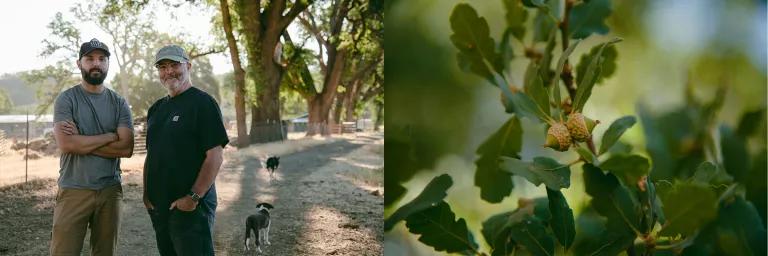
Clockwise from top: Ibérico pigs find shade and food beneath the oak trees at Encina Farms, which was cofounded by Helmut Drews (bottom left) and Alberto Solis (bottom right).
Now, the two ranchers are in the process of transforming 100 acres of irrigated pasture from annual forage plants to native perennials, such as wildrye grass. The longer roots of the perennials help create healthier, more porous soil, which improves water retention in a region increasingly plagued by drought. Drews and Solis are planning to start composting pig manure and spreading it over their fields, unlike the conventional approach of shunting waste into open pits. They have also acquired 70 cows to produce grass-fed beef. Using a practice called rotational grazing, they move the herd through a series of small paddocks to allow the grasses time to recover, nourished by the manure the cattle leave behind. Encina Farms doesn’t use chemical fertilizers or pesticides, hormones, or antibiotics. And Drews is already dreaming of expanding their operation and safeguarding more of Northern California’s native oak woodland—trees that act as natural carbon sinks and that are at risk of being razed to make way for vineyards or subdivisions.
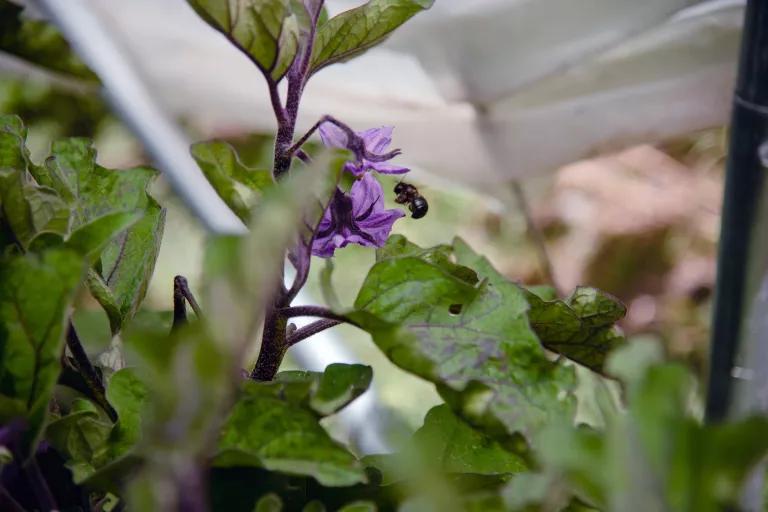
A carpenter bee visits a flower at Radical Family Farms in Sabastopol, California.
The Climate Equation
The benefits of the regenerative techniques that farmers and ranchers like Drews use go far beyond the paddock. The industrial agriculture industry is a significant source of U.S. greenhouse gas emissions, with myriad activities contributing to the tally. Farm equipment emits carbon dioxide as vehicles move across fields during tilling, planting, pesticide and fertilizer applications, and harvest. Transporting produce and livestock to market adds even more. Industrial farmers typically feed their animals corn and soy, which are grown in vast monocultures with fertilizers and pesticides produced via fossil fuels. During their digestive processes, cows and other ruminants also pass gas, in the form of methane, and their manure can also emit significant quantities of methane when stored in lagoons or holding pits. Meanwhile, nitrous oxide, another potent greenhouse gas, seeps into the air from bare soil and synthetic fertilizers.
However, agriculture also provides opportunities to counter climate change. Some research suggests that widespread trapping of carbon in soil through practices such as cover cropping, low- or no-till cultivation, and crop rotation could globally store up to the equivalent of eight billion metric tons of carbon dioxide per year—nearly matching current annual emissions from the burning of fossil fuels, though more research is needed to determine if the gains decline over time.
And composting manure, as Drews plans to do, helps decrease methane emissions. Additionally, building healthier soil by using compost, planting cover crops, and reducing tilling cuts down on the soil’s release of nitrous oxide.
Some fumigant pesticides, such as chloropicrin, also emit nitrous oxide, and the substances can hamper microbial life in the soil, reducing its ability to hold carbon. What’s more, producing pesticides is energy-intensive, and the chemicals prop up large mono-crop farms that export their produce, further adding to the industry’s carbon footprint. Sarah Aird, co-director of the nonprofit Californians for Pesticide Reform, says that reducing the use of these toxic chemicals to keep weeds and pests in check is a key part of mitigating climate change. “Pesticides are really critical to the conversation,” Aird says, “and they are being largely left out.”
Still, Aird is encouraged to see that ideas to revamp our agricultural system are moving beyond conversations into action. The Biden administration has cited agriculture as a “linchpin” of its strategy to combat climate change and has proposed allocating $1 billion to pay farmers $20 for each ton of carbon they trap in the soil. The proposed federal Healthy Soils Healthy Climate Act would similarly pay farmers for employing cultivation practices that sequester carbon in the soil, and if passed, would invest in research and provide technical support to farmers making the transition to climate-friendly practices. In California, a coalition of nonprofit organizations, small businesses, farmers, ranchers, and public health advocates is advancing a bond measure to invest more than $3 billion over five years to build a more equitable and resilient food system, one that embraces agricultural climate solutions, promotes farmworker safety, and combats hunger.
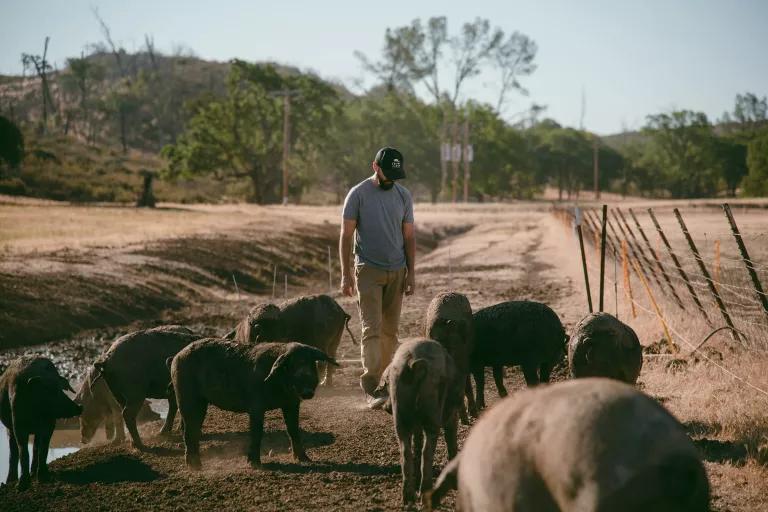
Drews tends to pigs bathing in the mud at Encina Farms.
From unprecedented fires and heat waves to droughts and floods, the climate crisis is already straining farmers’ and ranchers’ ability to raise crops and livestock. And the pandemic laid bare weaknesses in the country’s larger food system. COVID-19 hit farmworkers and workers at meat processing plants, who are predominantly people of color, especially hard. Crops went unharvested, while hunger increased. In California, alone, at least four million people now experience food insecurity.
“So much needs to be done to bring together the pieces of the food and farming system and to take a holistic, equitable approach that really tries to lift up sustainable agricultural solutions to our climate crises and to our social justice crisis,” says Jeanne Merrill, policy director of the California Climate & Agricultural Network (CalCAN), a coalition of sustainable and organic agricultural organizations. “We have the opportunity now to say: What is our vision for a resilient food and farm system? What are we going to do?”
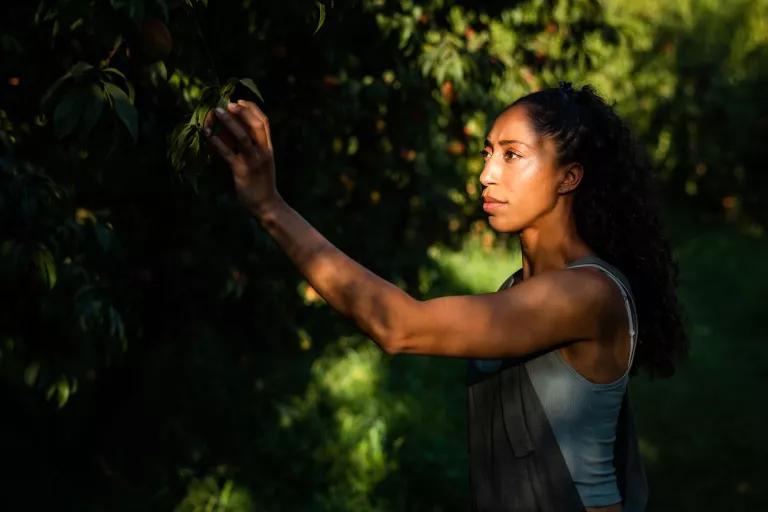
Amber Balakian, owner of Balakian Farm, picks a peach on her property.
James Collier for CA Grown
Roots and Growth
In the wake of World War I, Amber Balakian’s great-grandparents fled the Armenian genocide happening in what is now Turkey and eventually settled in the San Joaquin Valley, where they started a vineyard. Table grapes were their specialty, but it was Balakian’s mother, Ginger, who made the switch to organic farming on Balakian Farm’s 20-acre spread. Their crops vary from year to year but include true fruits, such as peaches and plums, along with summer squash and tomatoes—lots of tomatoes. Amid their bounty of heirloom tomatoes that bear little resemblance to the uniformly round, red, tasteless varieties available at typical grocery stores, they grow basil, a natural deterrent to some pests.
They also rotate crops, allow fields to rest and recuperate every few years, and use drip irrigation in order to lose as little water to evaporation as possible. “I love being on the farm and talking to people at farmers’ markets, explaining the behind-the-scenes parts of growing food,” Balakian says. “It’s also a lot of work.”
As a woman of color who owns a small farm, Balakian has encountered numerous barriers when it comes to securing funding. “It’s not easy,” she says. Last year, for instance, when Balakian contacted the U.S. Department of Agriculture about applying for a grant, the employee she spoke with helpfully identified a Value Added Producer Grant that she qualified for, but then suggested she hire a grant writer. “I was, like, I can’t afford that—I have to do this myself,” Balakian recalls. So she did, and she got the grant. “I have my master’s degree in management and operations, and I found [grant writing] hard,” Balakian says. “So I can only imagine what it’s like for other small farmers, who may not speak English fluently or don’t have experience doing this kind of paperwork.”
Throughout her many ups and downs, however, she says farmers’ markets have long been a consistent lifeline for Balakian Farms. It’s not just about having stall space—the markets also provide guidance about funding opportunities and help make connections with restaurants and other buyers. “I don’t think people realize the amount that these markets do for farmers,” Balakian says. “They support them in so many other ways.”
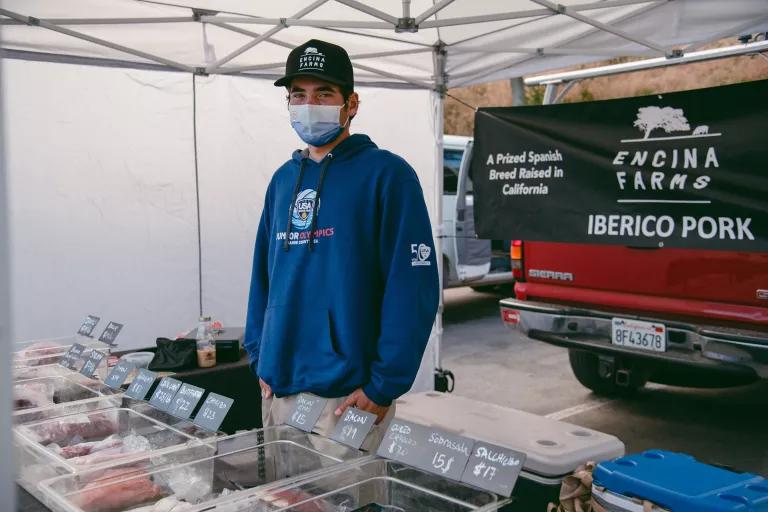
Encina Farms sales associate Andrew Nevland sells Ibérico pork at the farm’s stand at the Marin Farmers’ Market in San Rafael, California
Fruitful Connections
When COVID-19 hit, Andy Naja-Riese was committed to keeping farmers’ markets across the Bay Area running. His organization, the Agricultural Institute of Marin (AIM), oversees nine certified farmers’ markets where Balakian, Drews, and some 350 other farmers, ranchers, fishers, and small businesses from 43 of California’s 58 counties sell their food.
AIM prioritizes farmers who use organic or regenerative practices, who care for their farmworkers and livestock, and the organization’s farm audit program verifies that growers are true to their word.
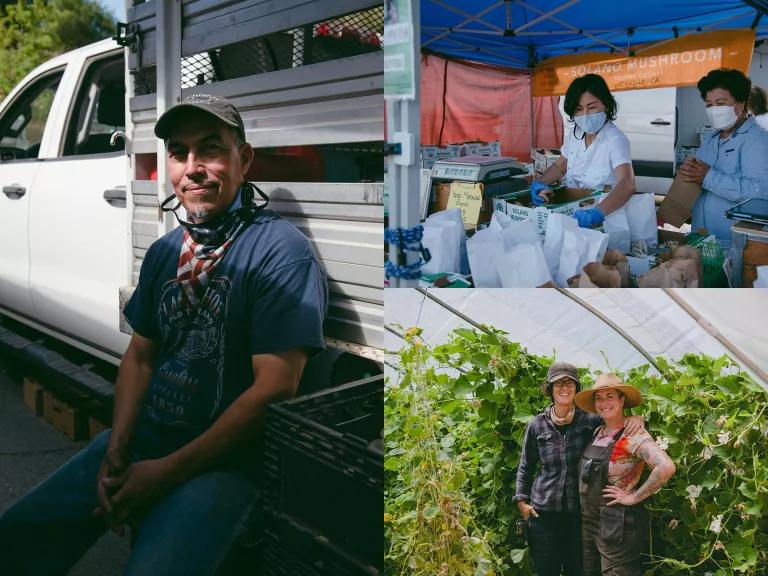
Clockwise from far left: Javier Toscano of Toscano Family Farm, which has grown organic fruits and vegetables in California’s San Joaquin Valley since 1991, at the Marin Farmers’ Market; Solano Mushroom Farm co-owner Sun Hee Shin (left) and farmstand worker Suki Grablin bag mushrooms at the Marin Farmers’ Market; Radical Family Farms founder Leslie Wiser (left) with her wife, Sarah Deragon, in one of the greenhouses on their farm, which grows fruits, vegetables, herbs, and flowers that honor Wiser’s mixed Asian-American heritage using regenerative farming techniques.
“The food system is set up so that large-scale industrial agriculture and multinational corporations are subsidized by the government to produce as much food as possible to feed as many people as possible. But in the United States, we have about 20 percent of households experiencing hunger, and 40 percent of our food is wasted,” says Naja-Riese. “It’s not a production problem—it’s a distribution problem. All these factors taken together create a food system largely not designed to support the people and small farmers AIM cares about.”
In addition to the markets, AIM has two programs that get fresh, affordable food from its farmers and ranchers into the hands of people who would otherwise have little access to it. The Rollin’ Root food truck is stocked with seasonal produce and dairy products and visits 11 senior housing and low-food-access sites a week. About a third of the customers qualify for federal nutrition benefits, and AIM has a matching program to make those dollars go further and to ensure that farmers get a fair price for their goods.
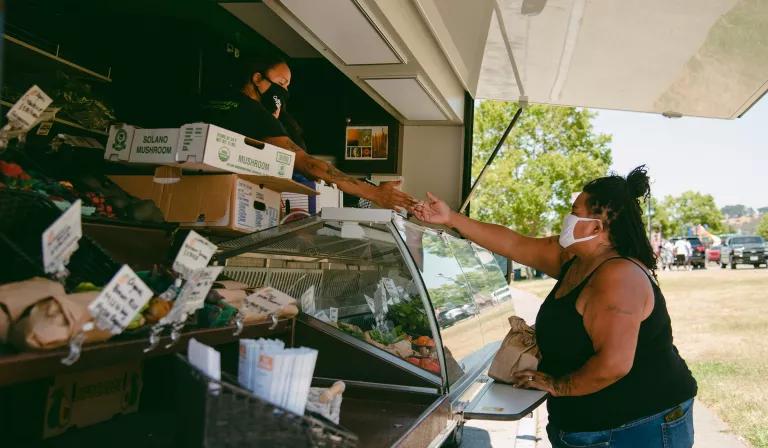
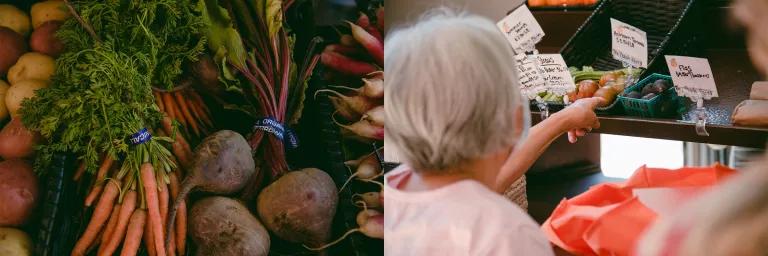
Customers shop at the Rollin’ Root mobile farmers’ market—which makes weekly stops to residents who are not able to easily access fresh produce—in Marin City and San Rafael, California.
When farmers lost restaurant accounts during the pandemic, AIM launched its Bounty Box program. Backed by funding from the Oakland A’s baseball team and Kaiser Permanente health-care company, the 15-pound boxes are filled with mostly organic items grown predominantly by female farmers and people of color and are sent to community centers in underserved areas. AIM also sells the boxes at three of its markets, where EBT cardholders can get them at half price. “These aren’t seconds,” Naja-Riese says. “It’s all fresh.”
Naja-Riese is one of the leaders from 16 organizations, including CalCAN and Californians for Pesticide Reform, who banded together to craft the proposed food and farming resilience bond act, AB 125. “It’s the first time I’ve seen a piece of legislation that looks at the food system from a holistic perspective,” he says. “Leaders from sustainable agriculture, food access, food process, and farmworker protection came together and said: We can build a better food system.”

Agricultural Institute of Marin CEO Andy Naja-Riese at the nonprofit’s Marin Farmers’ Market, which is one of the largest in the state, featuring nearly 200 local farmers and vendors
The bond would invest $637 million in farmworkers, providing affordable housing and other support; $750 million for infrastructure to combat hunger, including improving school meals; $700 million to bolster regional and local food processing, distribution, and market infrastructure; and $1.245 billion for sustainable agriculture, on-farm climate resilience and biodiversity, and compost facilities.
“We have this inequitable playing field that benefits big agribusinesses,” says Arohi Sharma, a water policy analyst at NRDC. “If policy treats agriculture only through the lens of farming, it misses all these other critical connections within and throughout a supply chain—water, soil microbe, and pollinator health; farmworkers; landowners; seed cleaners; farm-cooperative managers; distributors; butchers; consumers.”
The bond, Sharma says, would help level the playing field. Take meat processing, for example. The number of meat-packing facilities in the country has dropped from around 10,000 in 1967 to more than 800 today. That level of consolidation favors large ranches—something Drews has experienced firsthand.
During the pandemic, large ranches culled their herds for sale months earlier than usual. The sudden crush caused the processor Encina Farms had been using to not even be able to take a few of Drews’ hogs every couple weeks. Today, Encina Farms uses three companies, but Drews says the situation still feels precarious. Funds to increase local food-processing options would mean more business security for Drews and other small ranchers.
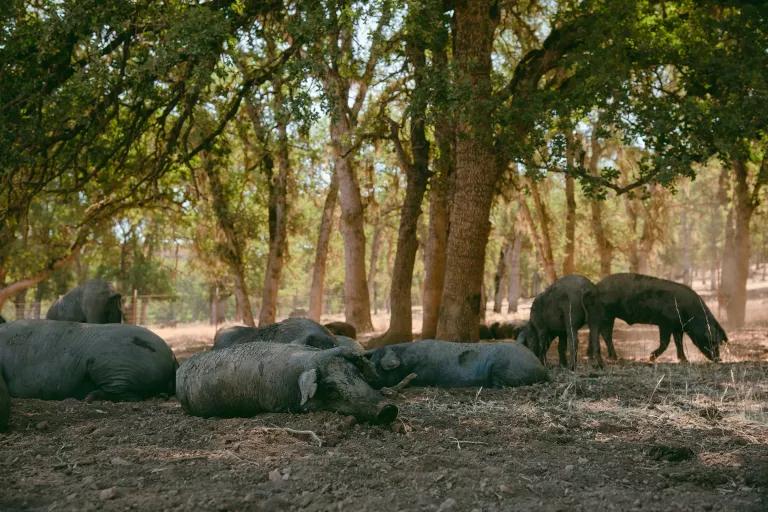
Ibérico pigs find shade and food beneath the oak trees at Encina Farms.
For now, Drews is making do, improving the farmland and keeping the hogs happy—a relatively easy endeavor this time of year, at the beginning of acorn season when the animals return to foraging in the oak forest. “When the acorns fall, the hogs just pounce on them,” he says. Drews is also busy hawking bacon and sausages and fresh cuts at farmers’ markets, which he says were critical to keeping his operation afloat during the pandemic. He estimates that a little more than half of Encina Farms’ revenue comes from repeat customers at the eight markets they attend.
One of those devotees is a 16-year-old who isn’t just wild about Iberian ham—he’s read all of the materials on the farm’s website and done additional reading on the Ibérico breed. “His mom says he doesn’t stop talking about it—the hogs, the acorns, the connection to the ecosystem,” Drews says. For this rancher, it’s a dream come true.
This NRDC.org story is available for online republication by news media outlets or nonprofits under these conditions: The writer(s) must be credited with a byline; you must note prominently that the story was originally published by NRDC.org and link to the original; the story cannot be edited (beyond simple things such as grammar); you can’t resell the story in any form or grant republishing rights to other outlets; you can’t republish our material wholesale or automatically—you need to select stories individually; you can’t republish the photos or graphics on our site without specific permission; you should drop us a note to let us know when you’ve used one of our stories.
Latina Farmworkers Speak Out about the Hazards of Life in California’s Fields
The Chlorpyrifos Ban Is a Win for Science—and Children
Valley Fever Spreads in California as Winter Rainstorms Intensify and Summers Heat Up